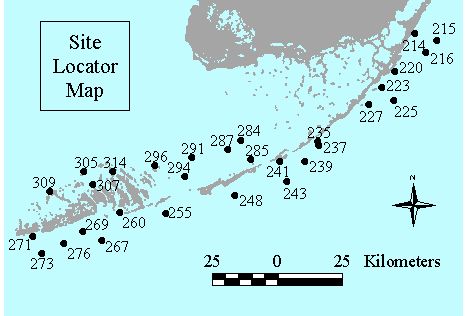
Seagrass Monitoring in the Florida Keys National Marine Sanctuary
Executive Summary, Annual Report - FY 1999
Project Principal Investigators:
James W. Fourqurean, Ph.D.
Southeast Environmental Research Center and Department of Biology
Florida International University
Miami, FL 33199
305-348-4096
Michael J. Durako, Ph.D
The University of North Carolina at Wilmington
Center for Marine Science and Department of Biology
One Marvin K. Moss Lane
Wilmington, NC 28409
(910) 962-2373
Joseph C. Zieman, Ph.D.
Department of Environmental Science
University of Virginia
Charlottesville, VA 22903
804-924-0570,
Project Manager:
Alan Willsie, Ph.D.
Southeast Environmental Research Center
Florida International University
Miami, FL 33199
305-348-4096,
Report Prepared and submitted on March 27, 2000
PROJECT OVERVIEW
The general objective of seagrass monitoring in the Florida Keys National Marine Sanctuary (FKNMS) is to measure the status and trends of seagrass communities to evaluate progress toward protecting and restoring the living marine resources of the Sanctuary. The scope and depth of this monitoring effort are without precedent or peer for seagrass ecosystems throughout the world. Specific objectives are: 1) To provide data needed to make unbiased, statistically rigorous statements about the status and temporal trends of seagrass communities in the Sanctuary as a whole and within defined strata; 2) To help define reference conditions in order to develop resource-based water quality standards; and 3) To provide a framework for testing hypothesized pollutant fate/effect relationships through process-oriented research and monitoring. In order to meet these objectives, we have developed these goals for the project:
! Define the present distribution of seagrasses within the FKNMS
! Provide high-quality, quantitative data on the status of the seagrasses within the FKNMS
! Quantify the importance of seagrass primary production in the FKNMS
! Define the baseline conditions for the seagrass communities
! Determine relationships between water quality and seagrass status
! Detect trends in the distribution and status of the seagrass communities
To reach these goals, four kinds of data are being collected in seagrass beds in the FKNMS:
! Distribution and abundance of seagrasses using rapid assessment Braun-Blanquet surveys
! Demographics of the seagrass communities using leaf-scar counting and population demographics techniques
! Seagrass productivity of the dominant species of seagrass in the FKNMS (Thalassia testudinum) using the leaf-mark and harvest method
! Seagrass nutrient availability using tissue concentration assays
These data are being collected at three different types of sites within the FKNMS:
! Level 1 Stations: Sampled quarterly for seagrass abundance, demographics, productivity and nutrient availability. These stations are all co-located with the water quality monitoring project’s stations (Figure 1)
! Level 2 Stations: Randomly selected locations within the FKNMS, sampled annually for seagrass abundance, demographics and nutrient availability. Each year, new locations for Level 2 stations are chosen.
! Level 3 Stations: Randomly selected locations within the FKNMS, sampled annually for seagrass abundance. Each year, new locations for Level 3 stations are chosen.
We are assessing both inter-annual and intra-annual trends in seagrass communities. The mix of site types is intended to monitor trends through quarterly sampling at a few permanent locations (Level 1 sites) and to annually characterize the broader seagrass population through less intensive, one-time sampling at more locations (Level 2 and 3 sites).
Figure 1. Permanent sites in the FKNMS

PROJECT ACCOMPLISHMENTS FY 1999
In 1997, we reported data from quarterly collections from 28 permanent (Level I) stations. In cooperation with the FKNMS Special Permitting Areas monitoring program, two additional permanent Level I stations were established in the Western Sambos and Carysfort Ecological Reserves, bringing the total number of permanent monitoring stations to 30. During FY 1996 through FY 1999 summer sampling of Level 2 and Level 3 stations was conducted in May - August, and the number of sites visited each year is listed below (Figure 2):
| 1996 | 1997 | 1998 | 1999 | |
| No. Level 2 Stations | 65 | 87 | 82 | 78 |
| No. Level 3 Stations | 141 | 187 | 191 | 258 |
| Total Stations | 206 | 274 | 273 | 336 |
Figure 2. Locations of sites sampled in the FKNMS, 1996-1999.
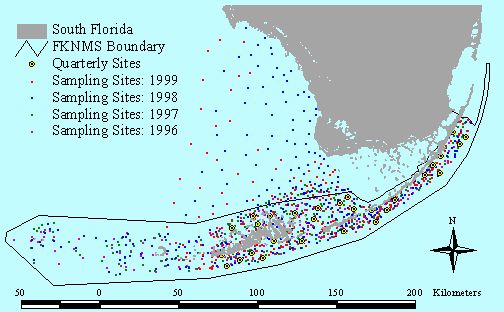
Spatial and temporal patterns in seagrass productivity
We assessed the efficacy of rapid visual surveys for estimating abundance of seagrasses in south Florida by comparing these results to more traditional analyses. At least one species of seagrass was present at 80.8 % of 874 randomly-chosen mapping sites, delimiting 12,800 km2 of seagrass beds in the 17,000 km2 survey area. Halophila decipiens had the greatest range in the study area; it was found to occur over 7,500 km2. The range of Thalassia testudinum was almost as extensive (6,400 km2), followed by Syringodium filiforme (4,400 km2), Halodule wrightii (3,000 km2) and Halophila engelmannii (50 km2). Abundance of seagrasses was seasonal, with seasonal maxima of standing crop about 32 % higher than the yearly mean. Productivity of T. testudinum, the dominant seagrass near-shore in the area, was both temporally and spatially variable (Figure 3). Yearly mean areal productivity averaged 0.70 g m-2d-1, with a range of 0.05 g m-2 d-1 to 3.29 g m-2 d-1. Specific productivity ranged between 3.2 and 34.2 mg g-1d-1, with a mean of 18.3 mg g-1d-1. Annual peaks in specific productivity occurred in August, and minima in February. Integrating the standing crop for the study area gives an estimate of 1.4 x 1011 g of T. testudinum and 3.6 x 1010 g of S. filiforme, which translate to yearly production of 9.4 x 1011 g of T. testudinum leaves and 2.4 x 1011g of S. filiforme leaves. Our rapid visual surveys proved useful for quantifying seagrass abundance, and the data presented in this paper serve as a benchmark against which future change in the system can be quantified.
Figure 3. Spatial pattern in seagrass productivity
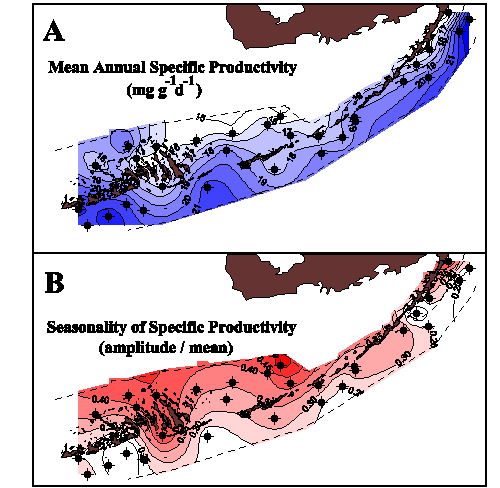
Seagrass Demographic Analysis
An examination of the population age structure of 130 spatially separated sub-populations of Thalassia testudinum over the extent of the Florida Keys National Marine Sanctuary (FKNMS) during a two year period revealed significant spatial variation in short shoot demographic characteristics and population dynamics. Shoot age was determined for 13,544 short shoots. The number of leaf scars on individual shoots was converted to shoot ages using observed seasonally-variable leaf emergence rates. The yearly mean leaf emergence rate was 0.0295 ± 0.0128 leaves SS-1d-1 (± 1 SD), and the median age of censussed shoots was approximately 5 years. A significant relationship between asexual reproductive output and gross recruitment of short shoots into the populations (r2 = 0.15, p = 0.001) and between mortality of short shoots and gross recruitment (r2 = 0.72, p < 0.001) existed. Thus, the greatest risk of mortality occurred in areas where gross recruitment was highest. The net population growth for T. testudinum within the boundaries of FKNMS was stable (mean = - 0.007 ± 0.092 y-1). However, areas within FKNMS fluctuated between positive and negative net growth rates (-0.20 y-1 to 0.50 y-1, Figure 4). The power of such large scale observations is the ability to identify areas of management concern and to frame questions that address the controlling mechanisms influencing these regions of fluctuating population growth.
Figure 4. Spatial pattern in predicted net population growth
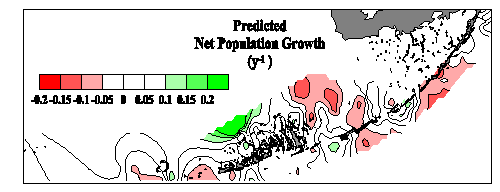
Key West Harbor Benthic Survey
In cooperation with commercial interests in the Key West Harbor area, we conducted a bottom survey of the harbor in May 1999 (Figure 5). We treated the 50 survey locations as regular synoptic survey stations in our program. We followed the standard project protocols in collecting the data. The data collected allowed for a mapping of sensitive benthic communities in the Harbor.
Figure 5. Summary map of benthic habitats of Key West Harbor
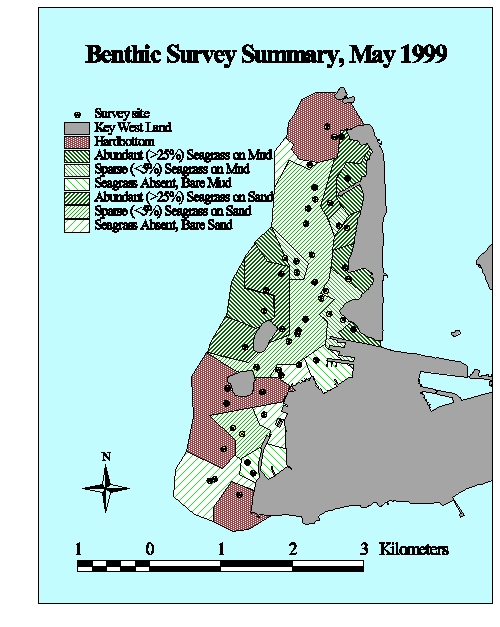
Data compilation in CD ROM format
We have compiled time series data and spatial maps from the monitoring effort for the period 1996 - 1999 on a CD. This CD allows for easy navigation through the data using internet browsing software; either by site for time series graphs or by taxa for distribution data. Limited numbers of the CD are available; please make a request for a copy to Jim Fourqurean at fourqure@fiu.edu.
Status and trends in seagrass communities in the FKNMS
Our surveys have provided clear documentation of the distribution and importance of seagrasses in the FKNMS. The seagrass bed that carpets 80% of the FKNMS is part of the largest documented contiguous seagrass bed on earth. These extensive meadows are vital for the ecological health of the FKNMS and the marine ecosystems of all of south Florida.
Synoptic surveys completed to date clearly describe the spatial extent of the seagrass beds, but these surveys were not designed to elucidate trends at this point, because sites were chosen randomly each year. Rather, the original EMAP protocols call for revisiting the exact sites in a second round of sampling. We propose that this second round of sampling be postponed until FY 2003, because the changes in the seagrass communities are expected to occur over this longer time scale. Second round data will allow for the direct comparison of the status of the seagrass communities at over 1000 sampling points.
Our permanent monitoring sites have provided valuable data on the inter- and intra-annual variability of seagrass cover and abundance. These 30 sites should continue to be monitored on a quarterly basis. There have been some striking trends in the seagrass communities at these permanent sites: seagrasses were lost completely at 3 of the 30 sites during hurricanes over the last 3 years. At the present time, human impacts have not been the apparent cause of any changes, but we do not understand completely the interaction man has with the natural dynamics of these systems.
Acknowledgments
This data report represents the dedicated work of many people. Craig Rose, Alan Willsie, Brad Peterson and Leanne Rutten led the field collection efforts and spearheaded the compilation of the data report; Cassandra Furst, Carlos Barrosso, Sean Meehan and Kevin Cunniff collectively put in the thousands of hours in the field and laboratory that went into the collection of these data. The field work was conducted under permits FKNMS-109-98 from the FKNMS, FDEP permit number 97S-774, FDEP Parks and Recreation Permit number 5-98-47, and a permit from the National Park Service.